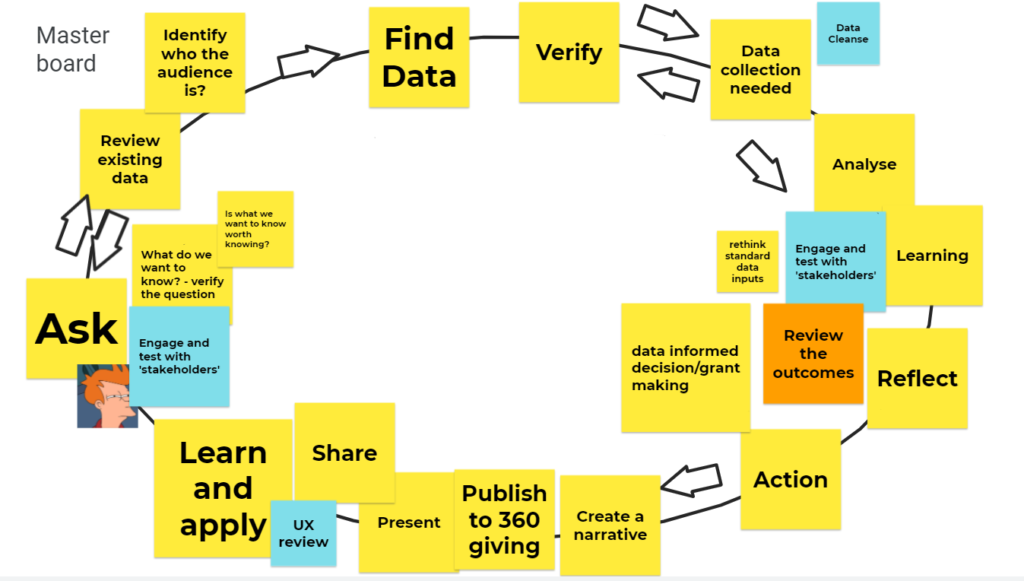Data Champions month 1: data workflows and data collection
In our Data Champions programme, we bring a cohort of funders together to collaborate and learn how to grow a data culture in their organisations. In the first month, we focused on data workflows and collecting data. In this blog, programme facilitator Dirk Slater shares the learnings and highlights from the group sessions.
In our Data Champions programme, people come together to collaborate and learn how to grow a data culture in their funding organisations.
Each month, the Data Champions attend one structured online workshop and one online discussion. The workshop focuses on a specific topic and has clear learning goals, while the discussion is more free-flowing and adapts to the participants’ needs and interests.
With 32 Data Champions in the (virtual) room, bringing experience from a variety of funding organisations across the UK, the workshop and discussion on 11 and 30 November 2020 were spaces for rich peer-learning.
Data workflows
What is a data workflow?
A ‘data workflow’ describes a process for utilising data. It begins with asking a question and potentially ends with taking action. Part of the workflow would ideally include making a decision, but if a decision can’t be made, then you might need more data or to ask a different question.
Why is it important for you and your organisation?
Identifying a data workflow is a step towards being intentional about your organisation’s use of data. It will help you to understand the effort and people that will be needed to undertake a data project.
Create your own data workflow
The School of Data has a useful data literacy tool called the Data Pipeline, which can provide a framework for understanding how data flows within your organisation. The pipeline labels the different stages of working with data as: define, find, get, verify, clean, analyse, and present.
In the Data Champions workshop, we went through the following steps to define and understand the data workflows that are relevant to each of our participants’ funding organisations.
- Get familiar with the Data Pipeline labels and what they mean
- Order the labels, using arrows to reflect how data flows in your funding organisation to draw the data workflow
- Consider who in your funding organisation is involved at each step of the workflow.

The group developed this data workflow collaboratively using Google’s interactive whiteboard system, jamboard.
Aha moments: data flows in cycles, and these cycles are iterative
The process of creating data workflows led the group to some interesting realisations, or ‘aha’ moments!
One take-away was that the data tends to flow in cycles. When a question is raised, often data is needed to answer it. This leads to action, which can raise more questions, which require more data to answer them. The cycle continues as the organisation builds upon learnings at each stage, and uses data to inform its decision-making.
Another take-away was that not getting the workflow right the first time is also part of the process. It must be a flexible, iterative framework, adapting as the organisation learns more.
Any organisation where people look for and use data to inform their decisions is on a learning journey. Data will shed light on unforeseen issues, bring new awareness and influence decision-making. Understanding how data flows within your funding organisation is a great place to start on this learning journey to support more effective grantmaking.
Data collection: 6 top tips
During the workshop, the group were particularly interested in data collection. So we embraced the opportunity for peer-learning and focused the online discussion on that.
Here are six ‘top tips’ that the group shared for effective data collection, based on their experience at their funding organisations:
1.Know your reason for collecting the data
Understand why you’re collecting the data, for what purpose and how it will be helpful. Avoid collecting data for the sake of it.
2. Don’t overlook planning
The planning stage is important for data collection, although it’s often overlooked. Include a review stage and time to consult stakeholders before you collect data. Part of planning is understanding that you are not likely to get it right the first time.
3. Make it work for everyone
How can the data collected be useful to everyone involved: both the groups that are asking for it, and those who are providing it?
4. Don’t collect unnecessarily
Know the data that you already have access to and avoid asking for it again, as this may cause frustration or disengagement.
5. Mind the gap
Don’t let gaps in your data accumulate and leave a legacy. Plan time into the project to fill those gaps.
6. Watch out for jargon
Watch out for jargon or technical terms when designing your process for data collection. Words that may be familiar to your team may be jargon to those you’re collecting the data from, which could lead to misunderstandings and inaccurate data.
Look out for blog 2: Building a data culture
Our next blog will highlight the key learnings and top tips from our Data Champions programme on topic 2: ‘Building a Data Culture’. In it, we will focus on adult learning, the idea of ‘data as a team sport’ and using data user profiles.
